BSP to be more cautious on lowering rates – S&P

MANILA, Philippines — The Bangko Sentral ng Pilipinas (BSP), along with other emerging market central banks, would be more cautious about cutting borrowing costs this year amid external risks, according to S&P Global Ratings.
In a report titled “Rising Challenges for Interest Rate Cuts,” the debt watcher said rising prices of commodities, particularly oil, may add renewed inflationary pressure for economies that are energy importers such as the Philippines.
“The recent rise in oil prices, if it persists, threatens to disrupt disinflation across most emerging markets (EMs). This could slow, or delay, central banks’ interest-rate reduction, as they were expected to ease policy in the coming quarters,” S&P said.
The credit rater noted that weaker external accounts could prompt central banks to be more cautious to prevent disorderly capital outflows.
“Among the major EMs, Chile, Hungary, Poland, Turkiye, the Philippines, Thailand and India are the largest net energy importers,” S&P said.
The BSP kept its benchmark rate steady at a near 17-year high of 6.5 percent for a fourth straight meeting in April. The Monetary Board raised borrowing costs by 450 basis points from May 2022 to October 2023.
BSP Governor Eli Remolona Jr. has signaled that monetary authorities may delay rate cuts this year if risks to inflation continue to persist.
The BSP believes inflation could quicken to above the two to four percent target range over the next two quarters.
Inflation averaged 3.3 percent from January to March, staying within the BSP’s two to four percent target range, despite picking up for the second straight month in March to 3.7 percent from February’s 3.4 percent.
The Monetary Board is scheduled to meet on May 16 to review the country’s monetary policy settings.
Market expectations of the US Federal Reserves’ next policy moves could also make it more challenging for EM central banks to ease policy, S&P said.
“Strong activity data and higher-than-expected inflation have pushed market expectations for the Fed’s first rate cut toward the end of the year, compared with the middle of the year just a few weeks ago,” it said.
After breaching the 57:$1 level last April 16, the local currency continued to depreciate against the greenback, closing at 57.65 on Friday. This marked the weakest peso close since November 2022.
Meanwhile, S&P expects growth to pick up to 5.9 percent in 2024 from 5.6 percent last year. The projected growth is below the six to seven percent target of the government for this year.
The Philippine economy is forecast to grow further to 6.2 percent in 2025 and 6.5 percent in 2026, before it slows to 6.4 percent in 2027.
The country currently falls short of the “A” rating from S&P Global Ratings, who has assigned an investment grade rating of ‘BBB+’ for the Philippines with a stable outlook.
- Latest
- Trending



























